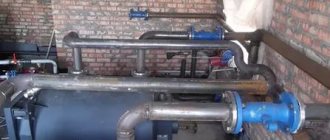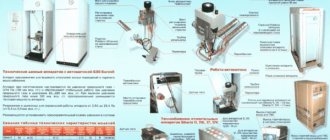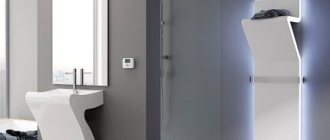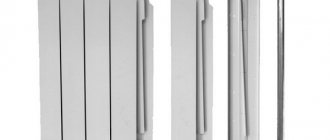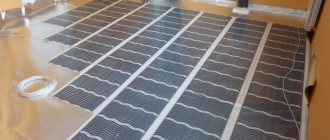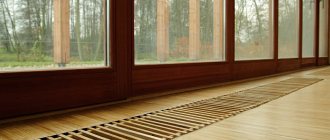Thermal radiators built into the floor are more often used in non-standard designs. In rooms that have panoramic windows, such batteries perform their functions without obstructing the open space. They not only heat the room, but also create a thermal curtain, preventing cold air from entering from the windows. Such devices are installed in private homes, winter gardens, gyms, offices and other social premises.
Heating radiators built into the floor
Externally, such a radiator looks like a pencil case, closed on top with a grille. Inside there is a device that directly heats the room. Let's take a closer look at heating radiators built into the floor, their advantages and disadvantages in use.
Radiator design
Heating radiators built into the floor consist of a finned heater, a housing and a panel covering the entire structure. They can be supplemented with fans for better heat distribution. The device is placed in the screed and sealed at the level of the floor covering.
Installation of radiators built into the floor.
Let's look at each element separately:
- The body of such a radiator is usually made of stainless steel. But for a dry room you can choose another material. The catch is that little-known companies often use low-quality technical steel, which is short-lived in operation. Be sure to ask the seller what material the case is made of.
Installation of radiators built into the floor.
- Finned heater or heat exchanger. It is a metal circuit with attached plates, soldered using a chemical composition with silver molecules. The plates are tightly connected to the base. Neither elevated temperatures nor constant changes in state as a result of expansion and contraction affect the strength of adhesion. Heat from the circuit is transferred to the plates, from which heat exchanges with the air.
Finned heater
- Floor gratings. They are installed at the level of the finishing coating and are intended to protect the structure from mechanical damage. They can be either removable or mounted together with the main radiator mechanism. The second option is sold ready for connection.
- Air fan. Installing a fan allows you to get more heat. It is connected to electrical networks, and vibration-proof supports are used to reduce noise levels. Radiators with existing fans produce more heat because they block the passage of cold air currents from the windows and prevent water droplets from forming on the glass.
Air fan
- Relief valve. The device for relieving the air gap is connected after installing the radiator built into the floor. Helps eliminate air congestion and increases the efficiency of such a heating system.
- Regulators. The presence of such devices allows you to set the desired temperature in the room.
Regulators
Note! Almost all floor-mounted heating radiators have a power regulator. You can select the heating level at any time.
- Inputs. Located at the end or side of the radiator. If it is impossible to use hot coolant, purchase electric batteries, which are also built into the floor.
Inputs
Aluminum heaters
These devices, very light, but at the same time quite durable, are usually used for autonomous heating, since low-quality coolants in centralized systems can cause rapid corrosion.
In addition, they are quite sensitive to surges in water pressure. They are produced in two ways:
- injection molding method, where step-by-step processing ensures maximum smoothness of surfaces, and an anti-corrosion coating is applied inside and outside, after which the body is coated with special powder paint
- an extrusion method in which the vertical parts are made of aluminum, and the manifold is made of silumin (aluminum-silicon alloy), hermetically connecting all parts to eliminate the risk of leaks.
Advantages of radiators built into the floor
Heating radiators built into the floor do an excellent job of heating rooms. Main advantages:
- The appearance of free space. Now nothing prevents you from placing interior items and furniture on the floor close to the wall.
- Hidden placement of the radiator. There is no need to buy appliances that match the design of the room.
- High performance of such a radiator with a long service life.
- Resistance to aggressive coolants, its reliability and compliance with all environmental safety requirements.
- Possibility of installing panoramic glazing.
Floor-mounted heating radiator
With all the positive qualities of heating radiators built into the floor , there are points that reduce their popularity. For example, it is best to install these devices during the construction of a house or its major renovation. And the batteries are connected with water as a coolant using a channel that is laid inside the floor. This makes installation difficult, especially if it is done in a cement screed.
Installation of a heating radiator built into the floor
conclusions
It is always necessary to maintain the correct distance from the wall to the heating radiator, regardless of the design of the product, its shape or other operational characteristics.
It does not matter what kind of heating system in a house or apartment: single-pipe or two-pipe, central or autonomous heating. In any case, space is needed for heat exchange between the air and the radiator.
If this rule is not followed, the energy efficiency of the heating system will be significantly reduced and the radiators will have a shorter service life. As a result, costs for energy resources, repairs or replacement of heating system components will increase.
Features of radiators
- Floor heating devices are produced with or without housings. The first ones are easier to install. First, prepare a trench along the length of the radiator, place the device in it and connect it to the communications. The dimensions of the boxes can range from 90 cm to 3 m, and allow you to choose the right option for any room.
- If you choose a simple and budget option without a housing, you will have to choose a way to securely attach the battery to the floor and make thermal insulation in order to avoid heat loss. Almost any material sold on the construction market that is resistant to heat and has a low thermal conductivity coefficient can be suitable as such a material.
- The simple design of the heat exchanger, consisting of a circuit and plates, is reliable and efficient in operation. It can be made of galvanized steel, aluminum and copper. The latter options are more expensive and have better power ratings due to the high degree of thermal conductivity and corrosion resistance.
- It is possible to increase power. If the existing unit is not sufficient to heat the room, the radiators can be equipped with an additional heat exchanger. The heated area increases by 2-3 times.
- You can choose your favorite floor grating design. It can be made from various materials and have different colors.
Various design of radiator grille built into the floor
Radiators built into the floor work in the same way as conventional wall-mounted heating devices, but they also have their own distinctive characteristics.
The nuances of using floor heating devices
A special feature of floor-standing radiators is their compact format. Consequently, they have a small volume of coolant. Therefore, it is not recommended to suddenly shut off the flow with control valves in a heated room; the temperature can quickly drop.
Compact electric convector for heating a small room
Open cracks in the upper plane of floor-standing appliances are a “trap” for small objects. Therefore, it is undesirable to install such models in a children's room without an additional decorative shield for steel radiators.
If we talk about the advisability of using decorative panels for low models, here the opinions of experts and consumers often differ. Floor-standing steam equipment is usually produced without any special design frills.
Decorative grilles are not provided for floor and baseboard heaters. As a rule, for sectional radiators they are purchased separately, at the request of the home owners or on the recommendation of the interior designer.
We offer protective grilles for various types of heating appliances:
- basement and in-floor;
- floor;
- wall (window sill);
- niche (built-in or in-wall).
Decorative radiators are equipped with an aesthetic plate and look more like a painting or installation than a heating device. Removable grilles are made from traditional materials:
- steel sheets;
- aluminum;
- decorative plywood and fiberboard;
- natural wood;
- laminated or veneered board and MDF.
The trench convector must be protected by a grille to prevent small objects from falling inside the device
Beautiful tubular and sectional radiators are most often used without decoration. They are painted to match the color of the walls or interior textiles
As built-in units and behind furniture, they are practically invisible, but it is important to think about how to hide the floor mounting for the radiators themselves
Decorative panels are a common way of decorating plate-and-panel models. This is a great way to hide equipment, but it “steals” up to 25% of the heat transfer.
There are also angular and radius models of floor-standing appliances, they are offered by the following companies:
- TM Carrera;
- Polvax;
- Verano;
- Jaga,
- Mohlenhoff;
- Minib.
Built-in and floor-mounted equipment powered by the network are most often installed in places where it is not possible to install or upgrade steam heating. Economically, they are less profitable, but heat fans are justified in country houses that are rarely visited in winter. With their help, warm air is quickly pumped into the room, like a heat gun.
How to choose
When purchasing electric floor heating radiators built into the floor, you need to start from the required dimensions and desired power. It is also worth deciding on the fan: is forced convection needed or will natural convection be sufficient?
When choosing built-in coolant batteries, many factors must be taken into account.
- Pressure in the heating system. Such radiators are suitable for heating houses with a closed heating network. Before installation in apartments of a multi-storey building, it is necessary to take into account the existing pressure. Such data can be obtained from the housing office or management company employees, and according to them, select the desired radiator model. Typically, such a device must withstand pressure up to 15 atmospheres.
- Parameters and type of coolant. If appliances built into the floor are installed in a private home, then any coolant is suitable, since the homeowner himself monitors its temperature and condition. For residents of high-rise buildings, filling radiators can create many problems. Therefore, when deciding to install built-in batteries, you need to find out in advance about the quality, Ph of the liquid, temperature, oxygen content and other characteristics of the coolant.
- Type of heating system and connection diameters. Many radiator models can function normally in single-pipe and two-pipe heating systems. But this information needs to be clarified with sellers. And if the diameters do not match, you can use adapters.
Single-pipe and two-pipe heating system wiring.
Note! Radiators built into the floor may be the only sources of heating in the room.
Types of systems
The price of a built-in heating radiator also depends not only on the material from which the convector is made, but also on the type of connection and operating principle. There are both those that run on electricity and water options.
In the electric version there are closed heating elements with copper or steel plates. They are suitable for a private home if it does not have central heating. Designed taking into account all safety rules, protected from malfunctions.
If you have a central heating system, then you need to install a water battery. A metal tube with plates is attached to the system using pipes. Copper, aluminum and steel are the material options the system can be made from.
Types of models
Two modifications of radiators are available: with natural and forced convection. The existing fans are powered from a 22 V network or a 12 or 24 V DC source.
Among the various built-in batteries, models designed for both heating and cooling are sold. Two-pipe and four-pipe devices are available. In the first version, the heat exchanger is connected to heating and cooling. In the second, there are two heat exchangers, each of which is connected to one of the systems. Such radiators are more efficient in operation, but also more expensive.
Non-standard types and sizes of radiators.
There are floor-standing models with a fresh air supply function. To do this, air is sucked in through a separate hole, passes through built-in filters, is heated and goes back into the rooms.
For non-standard rooms with existing floor curvature, you can order corner radiators or with the desired radius of curvature. There are heat exchangers on flexible hoses that allow you to take the device out onto the floor and put it back.
Electronic and mechanical thermostats allow you to control and change the temperature and power of radiators built into the floor. Such devices are located inside the case and are controlled using a remote control. Electronic options have the ability to program the heating temperature over time.
Thermostat for radiator
You can also select devices designed for high humidity levels. Such radiators use materials and electrical equipment that are resistant to corrosion. There is also a drainage drain through which condensate is discharged.
Cast iron batteries
These radiators have been used for a long time to this day. With the advent of new, lighter materials, preference began to be given to them, removing old, unaesthetic-looking cast iron radiators from apartments, but recently cast iron radiators have begun to come into fashion again.
And this is not surprising, because at a low cost they have enormous strength and high reliability.
But for many, the heavy weight and difficulty in maintaining are the fundamental disadvantages of this type of device.
Today cast iron products are produced in two types:
- classic budget “accordions” in the “cheap and cheerful” style in a wide variety of colors and options for painting
- exquisite expensive designer models in retro style, each of which is a kind of masterpiece, and the cost can be very, very high.
Recommendations from installation specialists
The first important step after deciding to install this type of radiator will be drawing up a project indicating all the factors: location, design dimensions, performance and the rest.
You need to purchase all the necessary equipment.
Installation of floor-mounted radiators
While pouring the screed, pipes are laid to supply coolant. And in the finished room, grooves are made into which the pipes will be placed. Next, a niche for the body is prepared. In this case, it should be larger than the radiator box by 5 mm in width and length when connected at the end, and by 10 mm when connected at the side. After this, the heating radiator is installed. At this stage, the main thing is to position the structure so that it does not protrude beyond the surface of the floor covering. The pipes are connected to the coolant supply pipes. The joints must be firmly fixed. To check, a test run of the heating system is usually carried out.
The final touch is laying the outer grating on the floor.
Radiator built into the floor
The calculation of the power and size of the device built into the floor is made according to parameters that take into account the height of the ceilings, the size of the windows, the average air temperature of the windows in winter, etc. Approximately they are selected in this way: per 1 square meter of area - 100 W of battery power.
Power and dimensions
We have decided on the material, now it’s time to calculate the number of sections and dimensions of the device that is most suitable for us
In a good way, many room parameters are taken into account here:
- square;
- ceiling height;
- wall thickness;
- the number of windows and how they are glazed;
- presence of a balcony;
- location: corner or in the middle of the building, first, last or middle floor.
In addition, it is important to take into account the climatic features of your region and personal preferences: do you like it when your home is cool or, conversely, hot. There is even a special calculator that, using a complex formula, will select the required power, taking into account the entered parameters. There is even a special calculator that, using a complex formula, will select the required power, taking into account the entered parameters
There is even a special calculator that, using a complex formula, will select the required power, taking into account the entered parameters.
Simplified, this formula looks like this:
N = S x 100 / Pc,
where N is the number of sections,
S – room area in square meters. m.,
Pc – power of one segment of the model you have chosen (indicated in the product passport)
There is an option where the ceiling height (h) is also taken into account:
N = S xhx 41 (34) / Pc.
Separately, it should be explained what the numbers 41 and 34 are, and which one should be used in your calculations. This is the power of the heating system per 1 sq. m. room, which is:
- 41 W in panel houses;
- 34 W in brick.
As for the height of the battery, it all depends on the place where you install it: if under a window, then you need to measure the distance from the top edge of the battery to the window sill, and from the bottom to the floor. There should be at least 10 cm of free space on each side. This is necessary to ensure proper convection. There are two standard values: 35 and 50 cm, so choose the one that best matches the dimensions of your apartment.
The depth also varies from 7 to 10 cm, so if you are limited in space, you can always take equipment of greater depth and thus increase its efficiency.
It is also important to know that placing it in a deep niche or installing a screen in front of the radiator leads to a decrease in heat transfer efficiency. In this case, it is advisable to increase the power of the installed device. There are devices that can be expanded by adding additional elements after installation
If you suddenly freeze in winter, you can buy a couple more parts and increase
There are devices that can be expanded by adding additional elements after installation. If you suddenly freeze in winter, you can buy a couple more parts and build them up.
For those cases where it is not possible to expand sections, you will have to buy an electric room heater to create a comfortable environment.
Flaws
Convectors built into the floor.
- To install such batteries, it may be necessary to increase the floor height. This will reduce the height of the room and require additional costs for the purchase of building materials.
- The price of heating devices is higher than that of conventional wall-mounted or floor-standing models.
- Such batteries are not the best option for rooms with ceiling heights of more than 3 meters. It would be better to purchase wall-mounted options.
- Batteries built into the floor are more difficult to install.
- If radiators have a forced convection system, then the electricity bill increases.
- Dust collects inside the batteries, and in the presence of forced convection, it can spread throughout the room.
Principle of operation
Heating is produced by convection, which allows us to call such equipment built-in convectors. The operation occurs in the following order: cooled air descends down through the grille mounted in the floor, and after heating it returns upward. There are certain types of heaters that are equipped with grilles with built-in fans that can provide heating naturally. Thanks to this, the heating of air masses occurs faster.
Heating grilles are made of wood or metal and painted with different colors, which allows the equipment to successfully fit into the interior of the room. The grilles themselves heat up slightly during operation - the heating temperature does not exceed 30 degrees, therefore, it is impossible to burn your hand or other part of the body in contact with the grilles.
Installation must be carried out close to window openings or doors made of glass. The radiators have a built-in relief valve that helps eliminate air in the heating system and also increases its operating efficiency. The valve must be connected directly after installing the heating equipment.
Note! Thanks to the presence of regulators, you can maintain the required temperature in the room.

